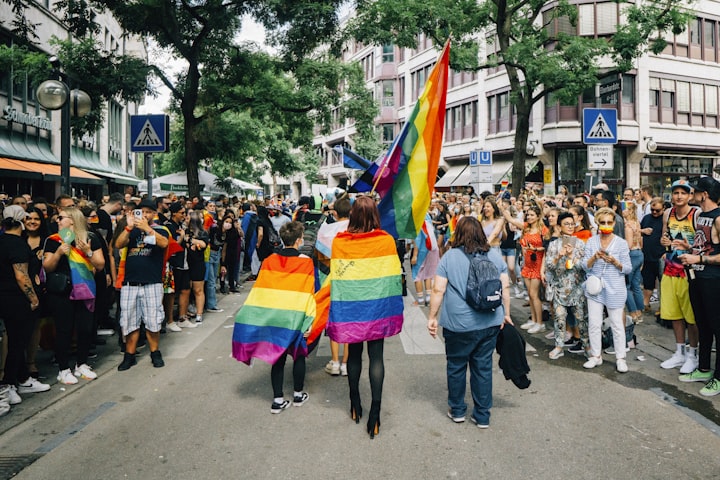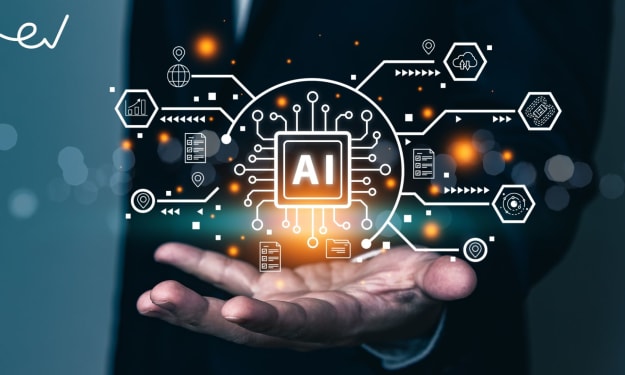Why Lesbian, Gay, Bisexual, Transgender Pride Month Is More Than Just A Celebration
Embracing Equality, Visibility, and Advocacy

Introduction
Pride Month is not your ordinary celebration. It's a time to honor the milestones, struggles, and achievements of the Lesbian, Gay, Bisexual, Transgender, Queer, Intersex and Asexual (LGBTQIA+) community. In this article, we will delve into the deeper significance of Pride Month, its history, the struggles of the LGBTQIA+ community, the role of allies, and the future of this important event.
Defining Pride Month
Pride Month is a month-long event held every June to commemorate the Stonewall riots of 1969. This event marked the beginning of the LGBTQIA+ rights movement. It's a time of celebration, remembrance, and reflection for the LGBTQIA+ community and its allies.
Brief history of Pride Month
The Stonewall riots were a series of demonstrations by members of the LGBTQIA+ community against police brutality and discrimination in Greenwich Village, New York City. The Stonewall Inn, a popular LGBTQIA+ bar, was raided by police on June 28, 1969, in a move that had become standard practice in that era. However, the patrons of the bar decided to fight back. The result was a riot that lasted for several days. The Stonewall riots are considered to be the turning point for the LGBTQIA+ rights movement.
The significance of Pride Month
Pride Month is a time for the LGBTQIA+ community to celebrate their identities, remember the struggles of the past, and advocate for their rights. It's also an opportunity to educate society on LGBTQIA+ issues and to create a more inclusive and accepting environment.
Understanding LGBTQIA+
Defining LGBTQIA+

LGBTQIA+ is an umbrella term used to refer to people who are lesbian, gay, bisexual, transgender, queer, intersex, and asexual. This inclusive acronym recognizes the diversity of the LGBTQIA+ community.
The different sexual and gender identities within LGBTQIA+
There are many different sexual and gender identities within the LGBTQIA+ community. Some people are attracted to people of the same gender (homosexual), some to people of a different gender (heterosexual), and others to people of both genders (bisexual). Gender identity refers to a person's internal sense of themselves as male, female, or non-binary.
Understanding gender identity vs. sex assigned at birth

Gender identity and sex assigned at birth are not always the same thing. Sex assigned at birth is based on physical characteristics such as genitalia. Gender identity, on the other hand, is a person's internal sense of themselves as male, female, or non-binary.
The Struggles of the LGBTQIA+ Community
Discrimination against LGBTQIA+ people

Discrimination against LGBTQIA+ people is widespread and includes verbal and physical abuse, employment discrimination, and housing discrimination. This discrimination can have devastating effects on the mental health and wellbeing of LGBTQIA+ individuals.
The fight for LGBTQIA+ rights

The fight for LGBTQIA+ rights has been ongoing for decades. This includes the right to marry, the right to adopt children, and protections against employment and housing discrimination.
The impact of anti-LGBTQIA+ laws and policies
Anti-LGBTQIA+ laws and policies have a significant impact on the lives of LGBTQIA+ individuals. These laws and policies can lead to higher rates of homelessness, poverty, and joblessness among the LGBTQIA+ community.
The mental health struggles of LGBTQIA+ individuals
LGBTQIA+ individuals are at a higher risk for mental health issues than the general population. This includes depression, anxiety, and suicide. Discrimination and social stigma can exacerbate these mental health issues.
The Importance of Visibility
The power of visibility in celebrating and empowering the LGBTQIA+ community
Visibility is important to the LGBTQIA+ community as it helps to break down stereotypes and increase social acceptance. It also empowers LGBTQIA+ individuals to be proud of who they are and to live their lives without fear of discrimination.
Visibility as a form of resistance
Visibility is also a form of resistance against discrimination and prejudice. By being visible, the LGBTQIA+ community is challenging societal norms and expectations.
The role of media in visibility and representation

Media representation is crucial to increasing visibility and social acceptance of the LGBTQIA+ community. Positive representation in movies, TV shows, and advertisements can help to break down stereotypes and increase understanding.
Pride Month as a Form of Resistance
The origins of Pride Month as a protest
Pride Month began as a protest against discrimination and violence towards the LGBTQIA+ community. It was a call to action for social change and a demand for equal rights.
The continued importance of protesting and activism in the LGBTQIA+ community
Protesting and activism are still necessary in the fight for LGBTQIA+ rights. There is still a long way to go in terms of achieving full equality for the LGBTQIA+ community.
Pride Month as a celebration of progress and a call to action for more change
Pride Month is not just a celebration of how far the LGBTQIA+ community has come, but also a call to action for further progress. It's a time to reflect on what still needs to be done to achieve full equality.
The Intersectionality of Pride Month

Exploring the intersections of race, ethnicity, religion, and LGBTQIA+ identity
The LGBTQIA+ community is diverse and intersectional. Many LGBTQIA+ individuals face intersecting forms of discrimination based on their race, ethnicity, religion, and other factors.
The importance of recognizing and celebrating diverse experiences within the LGBTQIA+ community
It's important to recognize and celebrate the diverse experiences within the LGBTQIA+ community. This includes amplifying voices from the intersectional communities that make up the LGBTQIA+ community.
Amplifying LGBTQIA+ voices from marginalized communities
Amplifying LGBTQIA+ voices from marginalized communities is crucial to creating a more inclusive and accepting society. This includes listening to and centering the experiences of LGBTQIA+ individuals who face multiple forms of discrimination.
The Celebration of Love and Relationships

Marriage equality and the significance of same-sex marriage
Marriage equality is an important achievement for the LGBTQIA+ community. It recognizes the love and commitment of same-sex couples and gives them access to legal benefits that were previously unavailable.
The impact of recognizing and celebrating LGBTQIA+ relationships
Recognizing and celebrating LGBTQIA+ relationships is important for increasing social acceptance and breaking down stereotypes.
The need for inclusive and LGBTQIA+-friendly services and industries
Inclusive and LGBTQIA+-friendly services and industries are important for ensuring that LGBTQIA+ individuals have equal access to employment, healthcare, and other services.
The Role of Allies in Pride Month
Understanding allyship and advocacy
Allies are non-LGBTQIA+ individuals who support the rights and well-being of the LGBTQIA+ community. Allyship involves listening, learning, and advocating for the LGBTQIA+ community.
The responsibilities of allies in supporting the LGBTQIA+ community
Allies have a responsibility to educate themselves, use inclusive language, show up for LGBTQIA+ events, and advocate for LGBTQIA+ rights.
Examples of allyship and advocacy in action during Pride Month
Examples of allyship and advocacy in action during Pride Month include attending Pride events, donating to LGBTQIA+ organizations, and using social media to promote LGBTQIA+ issues.
The Future of Pride Month

Challenges and opportunities for the LGBTQIA+ community
The LGBTQIA+ community still faces challenges in terms of achieving full equality. This includes ongoing discrimination and prejudice, as well as political and legal challenges.
The importance of continued activism and progress
It's important for the LGBTQIA+ community and its allies to continue to push for progress and to challenge discriminatory practices and policies.
The role of Pride Month in creating a more inclusive and accepting society
Pride Month has an important role to play in creating a more inclusive and accepting society. It's a time to celebrate diversity, raise awareness, and demand equality.
Conclusion
In conclusion, Pride Month is more than just a celebration. It's a time to honor the milestones, struggles, and achievements of the LGBTQIA+ community. It's a time to reflect on what still needs to be done to achieve full equality and to continue the fight for social justice. Let's all be allies and advocates for the LGBTQIA+ community, not just during Pride Month, but throughout the year.
FAQs
What is the purpose of Pride Month?
Pride Month is a time to celebrate the milestones, struggles, and achievements of the LGBTQIA+ community. It's also a time to educate society on LGBTQIA+ issues and to create a more inclusive and accepting environment.
Why is Pride Month important for LGBTQIA+ individuals?
Pride Month is important for LGBTQIA+ individuals because it's a time for them to celebrate their identities, remember the struggles of the past, and advocate for their rights. It's also an opportunity to educate society on LGBTQIA+ issues and to create a more inclusive and accepting environment.
What is meant by the term LGBTQIA+?
LGBTQIA+ is an umbrella term used to refer to people who are lesbian, gay, bisexual, transgender, queer, intersex, and asexual.
How can allies support the LGBTQIA+ community during Pride Month and beyond?
Allies can support the LGBTQIA+ community by educating themselves, using inclusive language, showing up for LGBTQIA+ events, and advocating for LGBTQIA+ rights. Examples of allyship and advocacy in action during Pride Month include attending Pride events, donating to LGBTQIA+ organizations, and using social media to promote LGBTQIA+ issues.
About the Creator
Mohammad Imran
✍️ Imran 🌟 Passionate content creator
📺 Sharing captivating stories and insightful perspectives
📝 Words that inspire and entertain
💡Join me on this creative journey! 🌍✨






Comments
There are no comments for this story
Be the first to respond and start the conversation.